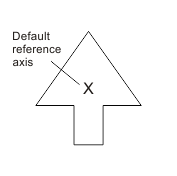
- - or -
Separation and shared edges
 Previous
Previous
- Next

In addition to the Search settings available for all Finder steps, you can also choose to specify how much separation is permitted between occurrences, as well as whether occurrences can share a common edge.

 Separation
Separation
The separation inputs determine the amount of possible overlap by separate occurrences. You can set the minimum separation for 5 criteria, which are: the Minimum separation X, Minimum separation Y, Minimum separation angle, Minimum separation scale, and Minimum separation aspect ratio. For an occurrence to be considered distinct, only one of the minimum separation conditions needs to be met. However, each of these separation criteria can be disabled so that it is not considered when determining a distinct occurrence.
The Minimum separation X and Minimum separation Y inputs determine the minimum distance required between distinct occurrences. This separation is specified as a percentage of the occurrence's size at the nominal scale. The minimum value that you can set is 0, which means that there is no minimum distance needed for occurrences to be distinct; all occurrences will be considered distinct regardless of other separation conditions. Setting a value larger than the size of the image is equivalent to disabling this separation condition since it will never be met.
The Minimum separation angle input determines the minimum difference in angle between distinct occurrences, as an absolute angle value. The default value is 10°. The minimum value that you can set is 0°, which means that there is no minimum difference in angle needed for occurrences to be distinct; all occurrences will be considered distinct regardless of other separation conditions. The maximum value that you can set is 180°, which is equivalent to disabling this separation condition.
The Minimum separation scale input determines the minimum difference in scale between distinct occurrences, as a scale factor. The default value is 1.1. The minimum value that you can set is 1.0, which means that there is no minimum difference in scale needed for occurrences to be distinct; all occurrences will be considered distinct regardless of other separation conditions. The maximum value that you can set is 4.0, which is equivalent to disabling this separation condition.
The Minimum separation aspect ratio input determines the minimum difference in aspect ratio between distinct occurrences. The default value is 1.1. The minimum value that you can set is 1.0, which means that there is no minimum difference in the aspect ratio needed for occurrences to be distinct; all occurrences will be considered distinct regardless of other separation conditions. The maximum value that you can set is 4.0, which is equivalent to disabling this separation condition.
The following examples illustrate the 5 separation criteria:

|
The model to the left has the following default settings:
|

|
This example illustrates a case with occurrences that have the same angle, aspect ratio, and reference position, but are separated by the minimum scale and are therefore considered distinct. |

|
This example illustrates a case with occurrences that have the same aspect ratio, scale, and reference position, but are separated by the minimum angle and are therefore considered distinct. |

|
This example illustrates a case with occurrences that have the same angle, scale, and reference position, but are separated by the minimum aspect ratio and are therefore considered distinct. |

|
This example illustrates a case with occurrences that have the same angle, scale, and aspect ratio, but are separated by the minimum distance in the X-direction and are therefore considered distinct. |
Note that for a model to be found, the number of visible edges in the occurrence must be sufficient to provide a match according to your acceptance levels.

 Shared edges
Shared edges
You can choose to allow occurrences to share common edges. Otherwise, edges that can be part of more than one occurrence are only considered part of the occurrence with the greatest score.
For example, in the illustration below, 2 occurrences share a common edge. With Shared edges set to Enable, these occurrences would have perfect scores.

However, with Shared edges set to Disable (default), the shared edge would be considered part of occurrence 1, since it has the greater score; the score of occurrence 2 would be subsequently reduced by the loss of the shared edge in the score calculation.
Enable Shared edges if defining a model that is part of a larger, already defined model. Otherwise, the smaller model occurrence might not be found.